Hyperlinked Documents: The Latest E-Discovery Challenge
As courts and discovery experts debate whether hyperlinked content should be treated the same as traditional attachments, legal practitioners are grappling with the technical and legal complexities of collecting, analyzing and reviewing these documents in real-world cases.
September 17, 2024 at 11:19 AM
8 minute read
The original version of this story was published on Law.com
What You Need to Know
- Dynamic files shared as links rather than attachments — known as hyperlinked documents — are emerging as a new frontier in the e-discovery landscape.
- The choice between sending a link or an attachment is often dictated by the platform.
- The evolving case law will continue to shape best practices, but proactive strategies and flexibility will be key to effectively managing hyperlinked content in e-discovery.

Dynamic files shared as links rather than attachments — known as hyperlinked documents — are emerging as a new frontier in the e-discovery landscape. As courts and discovery experts debate whether hyperlinked content should be treated the same as traditional attachments, legal practitioners are grappling with the technical and legal complexities of collecting, analyzing and reviewing these documents in real-world cases.
How Cloud Storage Changed File Sharing
Cloud storage services such as OneDrive, SharePoint, and Google Drive have revolutionized file sharing, facilitating collaboration in an increasingly global workplace. By sharing links, users can distribute documents quickly, bypassing email attachment limits and physical transfers. These links allow recipients to view and edit files in real time, ensuring they always see the most up-to-date version. While convenient, hyperlinked documents introduce significant challenges for e-discovery professionals.
NOT FOR REPRINT
© 2025 ALM Global, LLC, All Rights Reserved. Request academic re-use from www.copyright.com. All other uses, submit a request to [email protected]. For more information visit Asset & Logo Licensing.
You Might Like
View All

Less Is More: The Risks of Excessive Data Collection from Mobile Devices
6 minute read
Legal Writing Startup Clearbrief Raises $4M in New Funding Round

Elevate Acquires E-Discovery Company CJK Group to Grow Foreign Language Expertise
Trending Stories
- 1Court Rejects San Francisco's Challenge to Robotaxi Licenses
- 2'Be Prepared and Practice': Paul Hastings' Michelle Reed Breaks Down Firm's First SEC Cybersecurity Incident Disclosure Report
- 3Lina Khan Gives Up the Gavel After Contentious 4 Years as FTC Chair
- 4Allstate Is Using Cell Phone Data to Raise Prices, Attorney General Claims
- 5Epiq Announces AI Discovery Assistant, Initially Developed by Laer AI, With Help From Sullivan & Cromwell
Who Got The Work
J. Brugh Lower of Gibbons has entered an appearance for industrial equipment supplier Devco Corporation in a pending trademark infringement lawsuit. The suit, accusing the defendant of selling knock-off Graco products, was filed Dec. 18 in New Jersey District Court by Rivkin Radler on behalf of Graco Inc. and Graco Minnesota. The case, assigned to U.S. District Judge Zahid N. Quraishi, is 3:24-cv-11294, Graco Inc. et al v. Devco Corporation.
Who Got The Work
Rebecca Maller-Stein and Kent A. Yalowitz of Arnold & Porter Kaye Scholer have entered their appearances for Hanaco Venture Capital and its executives, Lior Prosor and David Frankel, in a pending securities lawsuit. The action, filed on Dec. 24 in New York Southern District Court by Zell, Aron & Co. on behalf of Goldeneye Advisors, accuses the defendants of negligently and fraudulently managing the plaintiff's $1 million investment. The case, assigned to U.S. District Judge Vernon S. Broderick, is 1:24-cv-09918, Goldeneye Advisors, LLC v. Hanaco Venture Capital, Ltd. et al.
Who Got The Work
Attorneys from A&O Shearman has stepped in as defense counsel for Toronto-Dominion Bank and other defendants in a pending securities class action. The suit, filed Dec. 11 in New York Southern District Court by Bleichmar Fonti & Auld, accuses the defendants of concealing the bank's 'pervasive' deficiencies in regards to its compliance with the Bank Secrecy Act and the quality of its anti-money laundering controls. The case, assigned to U.S. District Judge Arun Subramanian, is 1:24-cv-09445, Gonzalez v. The Toronto-Dominion Bank et al.
Who Got The Work
Crown Castle International, a Pennsylvania company providing shared communications infrastructure, has turned to Luke D. Wolf of Gordon Rees Scully Mansukhani to fend off a pending breach-of-contract lawsuit. The court action, filed Nov. 25 in Michigan Eastern District Court by Hooper Hathaway PC on behalf of The Town Residences LLC, accuses Crown Castle of failing to transfer approximately $30,000 in utility payments from T-Mobile in breach of a roof-top lease and assignment agreement. The case, assigned to U.S. District Judge Susan K. Declercq, is 2:24-cv-13131, The Town Residences LLC v. T-Mobile US, Inc. et al.
Who Got The Work
Wilfred P. Coronato and Daniel M. Schwartz of McCarter & English have stepped in as defense counsel to Electrolux Home Products Inc. in a pending product liability lawsuit. The court action, filed Nov. 26 in New York Eastern District Court by Poulos Lopiccolo PC and Nagel Rice LLP on behalf of David Stern, alleges that the defendant's refrigerators’ drawers and shelving repeatedly break and fall apart within months after purchase. The case, assigned to U.S. District Judge Joan M. Azrack, is 2:24-cv-08204, Stern v. Electrolux Home Products, Inc.
Featured Firms
Law Offices of Gary Martin Hays & Associates, P.C.
(470) 294-1674
Law Offices of Mark E. Salomone
(857) 444-6468
Smith & Hassler
(713) 739-1250






